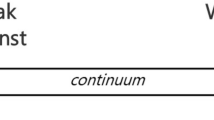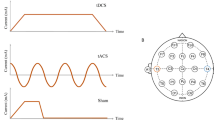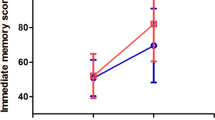Abstract
Transcranial direct-current stimulation (tDCS) appears to enhance cognitive function in Alzheimer’s disease (AD). Accordingly, over the last two decades, the number of studies using tDCS for AD has grown. This study aimed to provide a quantitative assessment of the efficacy of tDCS in improving cognitive function in patients with AD. We systematically searched the literature until May 2021 to identify relevant publications for inclusion in our systematic review and meta-analysis. Eligible studies were sham-controlled trials assessing the impacts of anodal or cathodal tDCS on cognitive function in patients with AD. The outcome measure of this study was the effects of tDCS on distinct cognitive domains including memory, attention, and global cognitive function. The initial search yielded a total of 323 records. Five other articles were found using manual search of the databases. Of these, 13 publications (14 different studies) with a total of 211 patients of various degrees of AD severity underwent meta-analysis. Meta-analysis revealed the non-significant effects of tDCS on attention (0.425 SMD, 95% CI, −0.254 to 1.104, p = 0.220), and significant positive impacts on the amelioration of general cognitive measures (1.640 SMD, 95% CI, 0.782 to 2.498, p < 0.000), and memory (1.031 SMD, 95% CI, 0.688 to 1.373, p < 0.000) dysfunction in patients with AD. However, the heterogeneity of the studies were high in all subdomains of cognition (ϰ2 = 22.810, T2 = 0.552, d.f. = 5, I2 = 78.80%, p < 0.000 for attention, ϰ2 = 96.29, T2 = 1.727, d.f. = 10, I2 = 89.61%, p < 0.000 for general cognition, and ϰ2 = 7.253, T2 = 0.085, d.f. = 5, I2 = 31.06%, p = 0.203 for memory). Improved memory and general cognitive function in patients with AD was shown in this meta-analysis. However, due to the small number of studies and the high heterogeneity of the data, more high-quality studies using standardized parameters and measures are needed before tDCS can be considered as a treatment for AD.
This is a preview of subscription content, access via your institution
Access options
Subscribe to this journal
Receive 12 print issues and online access
$259.00 per year
only $21.58 per issue
Buy this article
- Purchase on Springer Link
- Instant access to full article PDF
Prices may be subject to local taxes which are calculated during checkout





Similar content being viewed by others
References
Prince M, Bryce R, Albanese E, Wimo A, Ribeiro W, Ferri CP. The global prevalence of dementia: a systematic review and metaanalysis. Alzheimers Dement. 2013;9:63–75.e2. https://doi.org/10.1016/j.jalz.2012.11.007.
2021. Alzheimer’s disease facts and figures. Alzheimers Dement. 2021;17:327–406. https://doi.org/10.1002/alz.12328.
Fried I. Brain stimulation in Alzheimer’s disease. J Alzheimer’s Dis. 2016;54:789–91. https://doi.org/10.3233/JAD-160719.
van Boekholdt L, Kerstens S, Khatoun A, Asamoah B, Mc Laughlin M. tDCS peripheral nerve stimulation: a neglected mode of action? Mol Psychiatry. 2021;26:456–61. https://doi.org/10.1038/s41380-020-00962-6.
Riggs A, Patel V, Paneri B, Portenoy RK, Bikson M, Knotkova H. At-home transcranial direct current stimulation (tDCS) with telehealth support for symptom control in chronically-Ill patients with multiple symptoms. Front Behav Neurosci. 2018;12:93. https://doi.org/10.3389/fnbeh.2018.00093.
Woods AJ, Antal A, Bikson M, Boggio PS, Brunoni AR, Celnik P, et al. A technical guide to tDCS, and related non-invasive brain stimulation tools. Clin Neurophysiol. 2016;127:1031–48. https://doi.org/10.1016/j.clinph.2015.11.012.
Nitsche MA, Paulus W. Excitability changes induced in the human motor cortex by weak transcranial direct current stimulation. J Physiol. 2000;527:633–9. https://doi.org/10.1111/j.1469-7793.2000.t01-1-00633.x.
Vanneste S, Mohan A, Yoo HB, Huang Y, Luckey AM, McLeod SL, et al. The peripheral effect of direct current stimulation on brain circuits involving memory. Sci Adv. 2020;6. https://doi.org/10.1126/sciadv.aax9538.
Adair D, Truong D, Esmaeilpour Z, Gebodh N, Borges H, Ho L, et al. Electrical stimulation of cranial nerves in cognition and disease. Brain Stimul. 2020;13:717–50. https://doi.org/10.1016/j.brs.2020.02.019.
Roncero C, Kniefel H, Service E, Thiel A, Probst S, Chertkow H. Inferior parietal transcranial direct current stimulation with training improves cognition in anomic Alzheimer’s disease and frontotemporal dementia. Alzheimers Dement. 2017;3:247–53. https://doi.org/10.1016/j.trci.2017.03.003.
Ferrucci R, Mameli F, Guidi I, Mrakic-Sposta S, Vergari M, Marceglia S, et al. Transcranial direct current stimulation improves recognition memory in Alzheimer disease. Neurology. 2008;71:493–8. https://doi.org/10.1212/01.wnl.0000317060.43722.a3.
Boggio PS, Ferrucci R, Mameli F, Martins D, Martins O, Vergari M, et al. Prolonged visual memory enhancement after direct current stimulation in Alzheimer’s disease. Brain Stimul. 2012;5:223–30. https://doi.org/10.1016/j.brs.2011.06.006.
Boggio PS, Khoury LP, Martins DC, Martins OE, de Macedo EC, Fregni F. Temporal cortex direct current stimulation enhances performance on a visual recognition memory task in Alzheimer disease. J Neurol Neurosurg Psychiatry. 2009;80:444–7. https://doi.org/10.1136/jnnp.2007.141853.
Summers JJ, Kang N, Cauraugh JH. Does transcranial direct current stimulation enhance cognitive and motor functions in the ageing brain? A systematic review and meta- analysis. Ageing Res Rev. 2016;25:42–54. https://doi.org/10.1016/j.arr.2015.11.004.
Dedoncker J, Brunoni AR, Baeken C, Vanderhasselt MA. A systematic review and meta-analysis of the effects of transcranial direct current stimulation (tDCS) over the dorsolateral prefrontal cortex in healthy and neuropsychiatric samples: influence of stimulation parameters. Brain Stimul. 2016;9:501–17. https://doi.org/10.1016/j.brs.2016.04.006.
Horne KS, Filmer HL, Nott ZE, Hawi Z, Pugsley K, Mattingley JB, et al. Evidence against benefits from cognitive training and transcranial direct current stimulation in healthy older adults. Nat Hum Behav. 2021;5:146–58. https://doi.org/10.1038/s41562-020-00979-5.
Toril P, Reales JM, Ballesteros S. Video game training enhances cognition of older adults: a meta-analytic study. Psychol Aging. 2014;29:706–16. https://doi.org/10.1037/a0037507.
Bystad M, Grønli O, Rasmussen ID, Gundersen N, Nordvang L, Wang-Iversen H, et al. Transcranial direct current stimulation as a memory enhancer in patients with Alzheimer’s disease: a randomized, placebo-controlled trial. Alzheimers Res Ther. 2016;8:13. https://doi.org/10.1186/s13195-016-0180-3.
Inagawa T, Narita Z, Sugawara N, Maruo K, Stickley A, Yokoi Y, et al. A meta-analysis of the effect of multisession transcranial direct current stimulation on cognition in dementia and mild cognitive impairment. Clin EEG Neurosci. 2019;50:273–82. https://doi.org/10.1177/1550059418800889.
Sadigh-Eteghad S, Majdi A, McCann SK, Mahmoudi J, Vafaee MS, Macleod MR. D-galactose-induced brain ageing model: a systematic review and meta-analysis on cognitive outcomes and oxidative stress indices. PloS ONE. 2017;12:e0184122. https://doi.org/10.1371/journal.pone.0184122.
Cruz Gonzalez P, Fong KNK, Chung RCK, Ting KH, Law LLF, Brown T. Can transcranial direct-current stimulation alone or combined with cognitive training be used as a clinical intervention to improve cognitive functioning in persons with mild cognitive impairment and dementia? A systematic review and meta-analysis. Front Hum Neurosci. 2018;12:416. https://doi.org/10.3389/fnhum.2018.00416.
Liberati A, Altman DG, Tetzlaff J, Mulrow C, Gøtzsche PC, Ioannidis JP, et al. The PRISMA statement for reporting systematic reviews and meta-analyses of studies that evaluate health care interventions: explanation and elaboration. PLoS Med. 2009;6:e1000100. https://doi.org/10.1371/journal.pmed.1000100.
McKhann GM, Knopman DS, Chertkow H, Hyman BT, Jack CR Jr., Kawas CH, et al. The diagnosis of dementia due to Alzheimer’s disease: recommendations from the National Institute on Aging-Alzheimer’s Association workgroups on diagnostic guidelines for Alzheimer’s disease. Alzheimers Dement. 2011;7:263–9. https://doi.org/10.1016/j.jalz.2011.03.005.
Higgins JP, Altman DG, Gøtzsche PC, Jüni P, Moher D, Oxman AD, et al. The cochrane collaboration’s tool for assessing risk of bias in randomised trials. Bmj. 2011;343:d5928. https://doi.org/10.1136/bmj.d5928.
Motavalli A, Majdi A, Hosseini L, Talebi M, Mahmoudi J, Hosseini SH, et al. Pharmacotherapy in multiple sclerosis-induced cognitive impairment: a systematic review and meta-analysis. Mult Scler Relat Disord. 2020;46:102478. https://doi.org/10.1016/j.msard.2020.102478.
Borenstein M, Hedges LV, Higgins JP, Rothstein HR. A basic introduction to fixed-effect and random-effects models for meta-analysis. Res Synth Methods. 2010;1:97–111. https://doi.org/10.1002/jrsm.12.
Zwetsloot PP, Van Der Naald M, Sena ES, Howells DW, IntHout J, De Groot JA, et al. Standardized mean differences cause funnel plot distortion in publication bias assessments. Elife. 2017;6. https://doi.org/10.7554/eLife.24260.
Borenstein M, Hedges L, Higgins J, Rothstein H. Introduction to meta analysis (statistics in practice) Chichester: Wiley–Blackwell; 2009.
Gangemi A, Colombo B, Fabio RA. Effects of short- and long-term neurostimulation (tDCS) on Alzheimer’s disease patients: two randomized studies. Aging Clin Exp Res. 2021;33:383–90. https://doi.org/10.1007/s40520-020-01546-8.
Gangemi A, Fabio RA. Transcranial direct current stimulation for Alzheimer disease. Asian J Gerontol Geriatr. 2020;15:5–9. https://doi.org/10.1007/s40520-020-01546-8.
Inagawa T, Yokoi Y, Narita Z, Maruo K, Okazaki M, Nakagome K. Safety and feasibility of transcranial direct current stimulation for cognitive rehabilitation in patients with mild or major neurocognitive disorders: a randomized Sham-Controlled Pilot study. Front Hum Neurosci. 2019;13:273. https://doi.org/10.3389/fnhum.2019.00273.
Liu CS, Herrmann N, Gallagher D, Rajji TK, Kiss A, Vieira D, et al. A Pilot study comparing effects of bifrontal versus bitemporal transcranial direct current stimulation in mild cognitive impairment and mild Alzheimer disease. J ECT. 2020;36:211–5. https://doi.org/10.1097/yct.0000000000000639.
Cespón J, Rodella C, Miniussi C, Pellicciari MC. Behavioural and electrophysiological modulations induced by transcranial direct current stimulation in healthy elderly and Alzheimer’s disease patients: a pilot study. Clin Neurophysiol. 2019;130:2038–52. https://doi.org/10.1016/j.clinph.2019.08.016.
Khedr EM, Salama RH, Abdel Hameed M, Abo Elfetoh N, Seif P. Therapeutic role of transcranial direct current stimulation in Alzheimer disease patients: double-blind, placebo-controlled clinical trial. Neurorehabil Neural Repair. 2019;33:384–94. https://doi.org/10.1177/1545968319840285.
Suemoto CK, Apolinario D, Nakamura-Palacios EM, Lopes L, Leite RE, Sales MC, et al. Effects of a non-focal plasticity protocol on apathy in moderate Alzheimer’s disease: a randomized, double-blind, sham-controlled trial. Brain Stimul. 2014;7:308–13. https://doi.org/10.1016/j.brs.2013.10.003.
Cai M, Guo Z, Xing G, Peng H, Zhou L, Chen H, et al. Transcranial direct current stimulation improves cognitive function in mild to moderate Alzheimer disease: a meta-analysis. Alzheimer Dis Assoc Disord. 2019;33:170–8. https://doi.org/10.1097/wad.0000000000000304.
Roncero C, Kniefel H, Service E, Thiel A, Probst S, Chertkow H. Inferior parietal transcranial direct current stimulation with training improves cognition in anomic Alzheimer’s disease and frontotemporal dementia. Alzheimers Dement. 2017;3:247–53. https://doi.org/10.1016/j.trci.2017.03.003.
Im JJ, Jeong H, Bikson M, Woods AJ, Unal G, Oh JK, et al. Effects of 6-month at-home transcranial direct current stimulation on cognition and cerebral glucose metabolism in Alzheimer’s disease. Brain Stimul. 2019;12:1222–8. https://doi.org/10.1016/j.brs.2019.06.003.
Khedr EM, Gamal NF, El-Fetoh NA, Khalifa H, Ahmed EM, Ali AM, et al. A double-blind randomized clinical trial on the efficacy of cortical direct current stimulation for the treatment of Alzheimer’s disease. Front Aging Neurosci. 2014;6:275. https://doi.org/10.3389/fnagi.2014.00275.
Brunoni AR, Moffa AH, Fregni F, Palm U, Padberg F, Blumberger DM, et al. Transcranial direct current stimulation for acute major depressive episodes: meta-analysis of individual patient data. Br J Psychiatry. 2016;208:522–31. https://doi.org/10.1192/bjp.bp.115.164715.
Bridgman S, Engebretsen L, Dainty K, Kirkley A, Maffulli N. Practical aspects of randomization and blinding in randomized clinical trials. Arthroscopy. 2003;19:1000–6. https://doi.org/10.1016/j.arthro.2003.09.023.
Huo L, Zhu X, Zheng Z, Ma J, Ma Z, Gui W, et al. Effects of transcranial direct current stimulation on episodic memory in older adults: a meta-analysis. J Gerontol B Psychol Sci Soc Sci. 2021;76:692–702. https://doi.org/10.1093/geronb/gbz130.
Zheng X, Alsop DC, Schlaug G. Effects of transcranial direct current stimulation (tDCS) on human regional cerebral blood flow. NeuroImage. 2011;58:26–33. https://doi.org/10.1016/j.neuroimage.2011.06.018.
Marshall L, Mölle M, Hallschmid M, Born J. Transcranial direct current stimulation during sleep improves declarative memory. J Neurosci. 2004;24:9985–92. https://doi.org/10.1523/jneurosci.2725-04.2004.
Liebetanz D, Nitsche MA, Tergau F, Paulus W. Pharmacological approach to the mechanisms of transcranial DC-stimulation-induced after-effects of human motor cortex excitability. Brain. 2002;125:2238–47. https://doi.org/10.1093/brain/awf238.
Stagg CJ, Best JG, Stephenson MC, O’Shea J, Wylezinska M, Kincses ZT, et al. Polarity-sensitive modulation of cortical neurotransmitters by transcranial stimulation. J Neurosci. 2009;29:5202–6. https://doi.org/10.1523/jneurosci.4432-08.2009.
Hansen N. Action mechanisms of transcranial direct current stimulation in Alzheimer’s disease and memory loss. Front Psychiatry. 2012;3:48. https://doi.org/10.3389/fpsyt.2012.00048.
Fernández A, Maestú F, Amo C, Gil P, Fehr T, Wienbruch C, et al. Focal temporoparietal slow activity in Alzheimer’s disease revealed by magnetoencephalography. Biol Psychiatry. 2002;52:764–70. https://doi.org/10.1016/s0006-3223(02)01366-5.
Lefaucheur JP, Antal A, Ayache SS, Benninger DH, Brunelin J, Cogiamanian F, et al. Evidence-based guidelines on the therapeutic use of transcranial direct current stimulation (tDCS). Clin Neurophysiol. 2017;128:56–92. https://doi.org/10.1016/j.clinph.2016.10.087.
Andrade SM, de Mendonça CTPL, Pereira TCL, Fernandez-Calvo B, Araújo RCN, Alves NT. Adjuvant transcranial direct current stimulation for treating Alzheimer’s disease: A case study. Dement Neuropsychol. 2016;10:156–9. https://doi.org/10.1590/S1980-5764-2016DN1002013.
Costa V, Brighina F, Piccoli T, Realmuto S, Fierro B. Anodal transcranial direct current stimulation over the right hemisphere improves auditory comprehension in a case of dementia. NeuroRehabilitation. 2017;41:567–75. https://doi.org/10.3233/NRE-162062.
Masse C et al. Improvement of Response to Cueing after Left Prefrontal Transcranial Direct Current Stimulation in Alzheimers disease. Neuropsychiatry. 2018:1461–4.
Author information
Authors and Affiliations
Contributions
Study conception and design: AM and MML. Data extraction and analyses: AM and SSE. Additional input and interpretation: AM, LvB, and MML. Paper drafted by AM with input from LvB and MML. All authors reviewed and approved the submitted paper.
Corresponding author
Ethics declarations
Competing interests
The authors declare no competing interests.
Additional information
Publisher’s note Springer Nature remains neutral with regard to jurisdictional claims in published maps and institutional affiliations.
Rights and permissions
About this article
Cite this article
Majdi, A., van Boekholdt, L., Sadigh-Eteghad, S. et al. A systematic review and meta-analysis of transcranial direct-current stimulation effects on cognitive function in patients with Alzheimer’s disease. Mol Psychiatry 27, 2000–2009 (2022). https://doi.org/10.1038/s41380-022-01444-7
Received:
Revised:
Accepted:
Published:
Issue Date:
DOI: https://doi.org/10.1038/s41380-022-01444-7
This article is cited by
-
Cognitive reserve predicts episodic memory enhancement induced by transcranial direct current stimulation in healthy older adults
Scientific Reports (2024)
-
Transcranial direct current stimulation for global cognition in Alzheimer’s disease: a systemic review and meta-analysis
Neurological Sciences (2024)
-
Kognitive Begleiteffekte neurostimulativer Therapieverfahren
Clinical Epileptology (2023)
-
Effects of online parietal transcranial electric stimulation on associative memory: a direct comparison between tDCS, theta tACS, and theta-oscillatory tDCS
Scientific Reports (2022)



